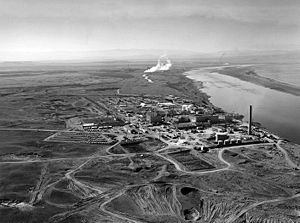- N-Reactor
-
The N-Reactor was a graphite-moderated nuclear reactor constructed during the Cold War and operated by the U.S. government at the Hanford Site in Washington.
It was a one-of-a-kind design in the U.S., being both a power reactor used to feed the civilian electrical power grid via the Washington Public Power Supply System (WPPSS), and a plutonium production reactor for nuclear weapons.
N-Reactor was built with a confinement building instead of a containment building. In the event of an accidental release of steam, air and steam would vent through filters that confined any radioactive particles present.[1] It was partially moderated with graphite, but had a negative void coefficient, meaning it was thermally stable.[2]
The reactor was placed on cold standby in 1988, with "final disposition" beginning in 1994.
See also
References
- ^ US Department of State Bulletin, "Soviet nuclear reactor accident at Chernobyl"
- ^ [David Bodansky, Nuclear Energy Principles, Practices, and Prospects, 2004]
External links
Coordinates: 46°40′29″N 119°34′07″W / 46.674677°N 119.568672°W
Categories:- Graphite moderated reactors
- Nuclear power stubs
Wikimedia Foundation. 2010.

